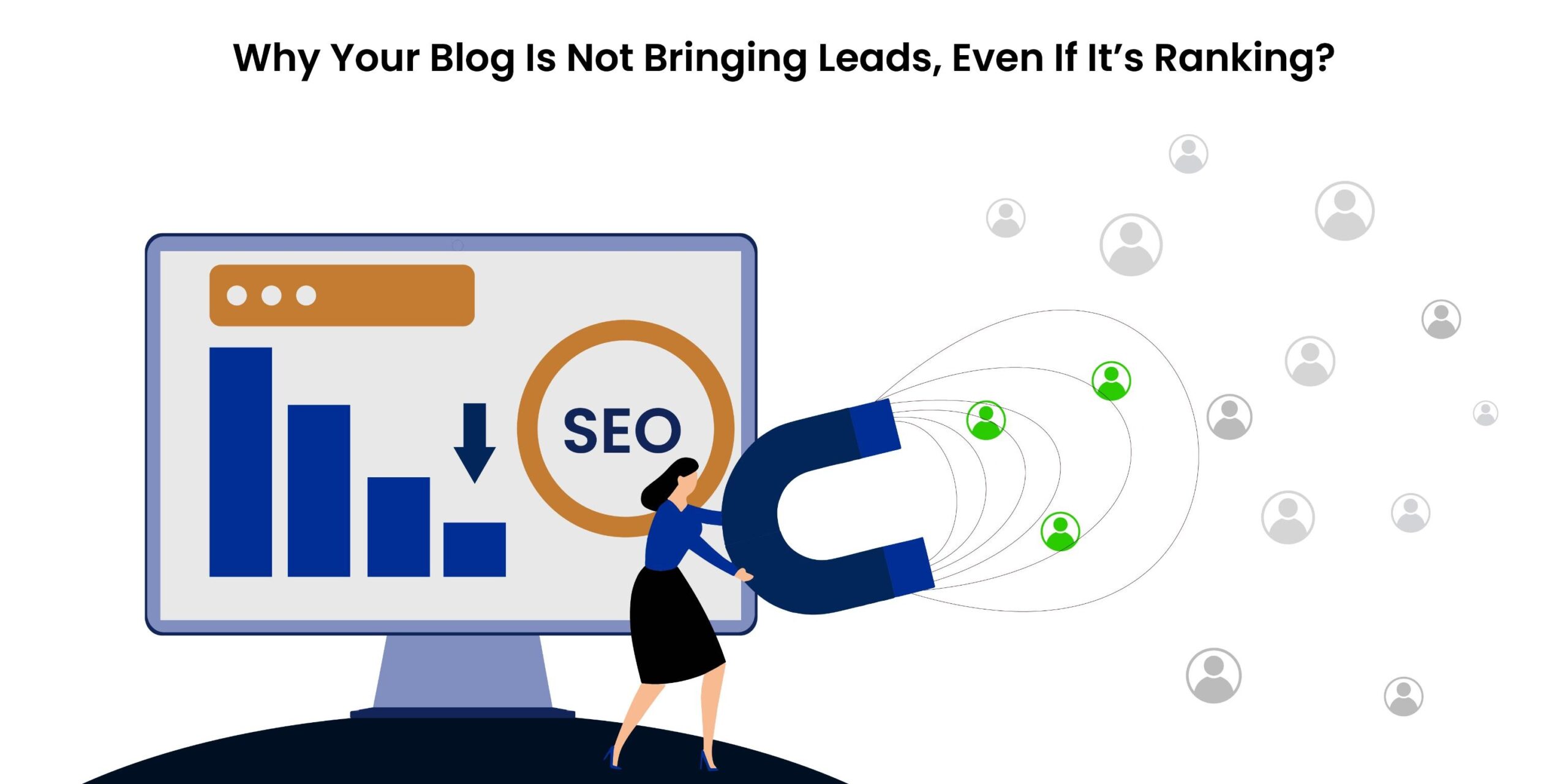
7 Blog Mistakes That Are Costing You Real Leads
08 August 2025
- Most B2B blogs underperform because they chase search rankings instead of audience resonance.
- High-performing blogs go beyond SEO checklists. They bring a distinct POV, address buyer pain points, and map content to each stage of the customer journey.
- Even the best-written blogs fall short without ownership, smart distribution, and a plan to repurpose content across channels.
Panchalee Thakur
What got your blog here won’t get it there.
The world of organic search has changed considerably in recent times. And the impact is evident in blog performance.
Gartner predicts that by 2028, brands will see a 50 percent decline in organic search traffic as buyers move to generative AI-powered search.
Google’s AI summaries are also to blame. In July 2025, the European Publishers Alliance took a stand by filing an antitrust complaint against Google over the growing dominance of zero-click searches. As many as 69 percent of news searches reportedly ended without a click to a news site in May 2025, up from 56 percent in May 2024. Why? Google’s AI-generated overviews serve up quick answers without requiring users to click through to the information source.
The numbers may differ by industry, but the impact is universal. Even high-ranking blogs are losing clicks to AI overviews and changing user behaviors.
On the positive side, search volumes continue to rise, both on Google and Gen AI platforms. So, there is sufficient room to grow traffic to your blog and enhance your authority.
However, the biggest threat isn’t AI. Today, most B2B content feels like a flat, predictable remix, built on the same templates and using similar language.
Moreover, ranking alone won’t get you far anymore. A blog might land on the first page of search results, but if it does not capture attention or inspire action, the visibility is wasted. Even highly ranked articles are frequently ignored by readers as AI summaries increasingly respond directly to search requests. This is the reason why blog success in the AI era is not just about Search Engine Optimization (SEO); it also demands a unique voice, subject matter depth, and real value that cannot be summarized in a sentence or two by a search engine.



Why Isn’t Your Blog Delivering Expected Results?
Let’s look at the top reasons that are holding your blog back, and how to fix that:
1. The Blog Only Shares What’s Already Known
If your blog sounds like it could have been written by anyone, it won’t leave a mark. Readers will scan and bounce from your article if it doesn’t offer anything that hasn’t already been said by someone else. Even worse, AI overviews might summarize your piece without giving readers a reason to engage further.
What You Should Do Instead?
Bring a unique viewpoint. Share lived experiences, fresh analogies, or observations that cannot be pulled from a quick search. If you are covering a familiar subject, make it specific to your audience’s circumstances or pain points.
Instead of “How to write better email subject lines,” consider: “Why one SaaS brand doubled open rates with this counterintuitive subject line approach.”
Agency Tip:
Always ask yourself this before you start writing: “Will this topic give your readers a new insight or help them solve their pain points?” If the answer is no, you need to rethink your angle.
2. It is Only a Keyword Dump
Many B2B marketers still treat SEO like a formula. Without any true context, keywords are crammed into the blog, leading to articles that may rank for a while, but rarely deliver lasting value or significant engagement.
What Can You Do Instead?
Treat SEO as a support system, not your sole strategy. Before writing, understand what your audience is searching for. While looking for keywords, also focus on the intent behind them and uncover the challenges your audience is trying to solve.
After you have a clear understanding of the topic, lead from a human perspective. Tell a story or offer a thought that brings the subject to life. Consider keywords to be the ingredients rather than the recipe.
For instance, if your keyword is “B2B blog strategy,” instead of writing an article on “B2B Blog Strategy Tips”, cover one on “What Building My First B2B Blog Taught Me About Strategy, Mistakes, and Momentum.” Let the keyword support the story, instead of defining it.
Agency Tip:
Before initiating the article, we note down questions that your target audience cares about. Once the storyline is fixed, we optimize it for search without sacrificing clarity or voice.
3. It is Too Generic to be Important
Titles like “How to grow your business” and “Marketing trends in 2025” might sound promising but are too general to offer any real value. They try to encompass everything, and end up saying nothing useful. Readers leave because they don’t find anything targeted or actionable.
What Can Be Done Instead?
Narrow your focus. Craft content for a specific audience with a clear need rather than attempting to please everyone. Create micro-segments based on pain-point clusters, business maturity stages, or industry verticals. Write with these micro-segments in mind.
Specificity is about including insights, data, and frameworks that resonate with the reader. It enables you to make a statement, go deeper, and provide substance.
For instance — rather than crafting another generic blog on Top marketing trends in 2025 — consider something more targeted, like – How AI is changing account-based marketing for mid-sized B2B companies in 2025.
It is timely, targeted, and speaks directly to a specific problem and audience.
Agency Tip:
We employ the “Niche x Insight x POV” formula for all of our blogs.Every topic must pass 3 filters: For whom is this intended? What is the new realization? Why is it important now? If we cannot respond to all three, we change the angle.
4. There is No Real POV
A lot of B2B blogs are nothing more than safe summaries. Stats. Buzzwords. Vague and sweeping statements. No takeaways.
Such articles only fill space. They won’t spark interest or build authority for your organization.
Here’s What You Can Do Instead:
Take the lead by sharing your viewpoint. Let your blog represent what your brand stands for, whether that is based on your leaders’ vision, client experiences, or internal data. In crowded spaces, a well-articulated POV can help your content stand out. If you are building thought leadership in your content mix, check out our blog on what business leaders must know about thought leadership content.
Agency Tip:
We build blogs around founder and CXO viewpoints. Before writing, we gather their thoughts and build narratives that are personal and informed. That is how you create thought leadership, not thought repetition.
5. It is Not Created with Distribution in Mind
Publishing a blog and expecting traffic to find its way to it is like launching a product without any marketing plan. Hitting publish is just the beginning. If you are not actively promoting your content, it dies in silence.
Especially in the AI era, where summaries drown your voice and nuance, you need to establish your own channels of discovery.
Consider this Instead:
Approach distribution as an integral part of the writing process rather than a post-publication afterthought. You need to identify where your audience spends time and meet them there with the content that speaks to them.
Answer the questions below to build distribution touchpoints into your content strategy:
- Who is the target audience for this content?
- On which platforms are my customers mostly active?
- Can this article be repurposed into various formats, such as videos, snippets, or carousels?
- Can sales or marketing team use this in their pitches?

Agency Tip:
At the start of the blog, we identify 3 key personas who will engage most with the piece. Then we build distribution hooks tailored to each one, from sales snippets to leadership POVs and social-first formats.
6. It Does Not Support the Buyer Journey
Most B2B blogs stay in the awareness stage. They define broad issues or describe industry trends, but they do not help users move closer to a solution or conversion.
Do This Instead:
Develop your blog library, keeping the buyer journey in mind. Create specific types of content for each stage—awareness, consideration, and decision.

Additionally, every blog should include a CTA aligned to the reader’s stage, whether it is to read another resource, download a guide, or contact sales.
Agency Tip:
Every quarter, we examine the blog archives of our clients and assign a funnel stage to each post. If the middle or bottom funnel is weak, we fill those gaps first. Distribution comes after alignment.
7. No One Owns the Blog Strategy
When blog ownership is unclear, voice shifts, priorities get diluted, and publishing becomes irregular.
The result: the blog loses its appeal and value to readers.
Here’s What Can Be Done:
Assign clear roles for every aspect of managing your blog. Whether it is a dedicated in-house content person or a trusted agency partner, there should always be a go-to person for:
- Strategy and goal alignment
- Editorial calendar and consistency
- Workflows for voice, tone, and review
- Performance analysis and ongoing optimization
Agency Tip:
At the start of all our content partnerships, we build a scalable editorial system during onboarding, complete with tone guides, formatting guidelines, pillar topic maps, and approval checkpoints. The goal is to ensure the blog reflects the brand’s strategy and is mapped to marketing goals.
Blogs Are Not Dead. Boring Ones Are.
If your B2B blog is not generating traffic, engagement, or leads, it is not a volume issue. It is a value issue.
The most effective blogs are not just keyword-aligned, but are also conversation starters, trust builders, and conversion levers.
When executed with strategic clarity and a compelling voice, your blog can:
- Open high-intent sales conversations
- Establish your leadership in niche categories
- Create a content library your team can use across touchpoints
- Fuel your email, social, and event strategies with ready-to-use insights
Here’s one last Agency Tip:
We assess every blog using this 3-part performance filter:
- Readability: Is it clear, engaging and easy to consume?
- Resonance: Does it make the audience feel understood, inspired, or smarter?
- Repurposability: Can it empower your social, sales, email strategies, and other marketing efforts across touchpoints?
If it does not check all three, it is not ready to go live.
At Purple Iris, we help organizations create content that connects with the right audience, at the right time, with the right message.
Discover how our services can bring that edge to your content strategy.
